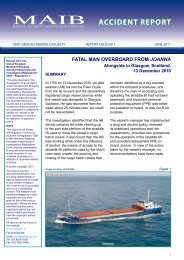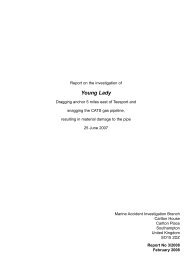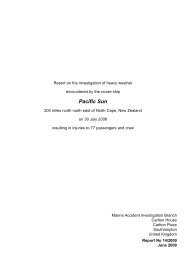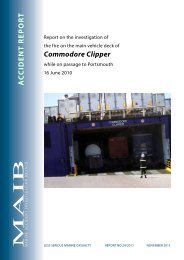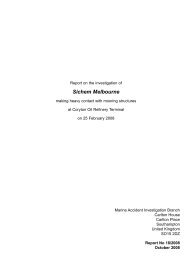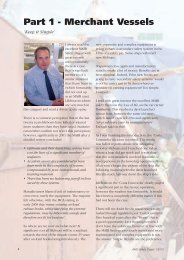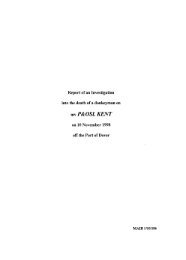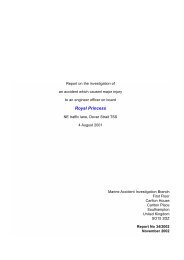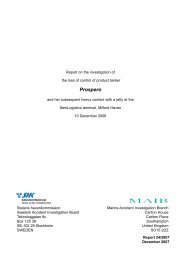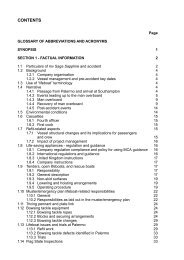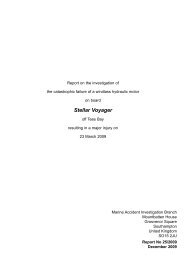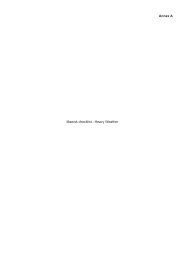Saga Rose - Marine Accident Investigation Branch
Saga Rose - Marine Accident Investigation Branch
Saga Rose - Marine Accident Investigation Branch
Create successful ePaper yourself
Turn your PDF publications into a flip-book with our unique Google optimized e-Paper software.
Report on the investigation of<br />
the fatality on board<br />
passenger cruise ship<br />
<strong>Saga</strong> <strong>Rose</strong><br />
in Southampton, England<br />
on 11 June 2008<br />
<strong>Marine</strong> <strong>Accident</strong> <strong>Investigation</strong> <strong>Branch</strong><br />
Carlton House<br />
Carlton Place<br />
Southampton<br />
United Kingdom<br />
SO15 2DZ<br />
Report No 01/2009<br />
January 2009
Extract from<br />
The United Kingdom Merchant Shipping<br />
(<strong>Accident</strong> Reporting and <strong>Investigation</strong>)<br />
Regulations 2005 – Regulation 5:<br />
“The sole objective of the investigation of an accident under the Merchant Shipping<br />
(<strong>Accident</strong> Reporting and <strong>Investigation</strong>) Regulations 2005 shall be the prevention of<br />
future accidents through the ascertainment of its causes and circumstances. It shall<br />
not be the purpose of an investigation to determine liability nor, except so far as is<br />
necessary to achieve its objective, to apportion blame.”<br />
NOTE<br />
This report is not written with litigation in mind and, pursuant to Regulation 13(9) of<br />
the Merchant Shipping (<strong>Accident</strong> Reporting and <strong>Investigation</strong>) Regulations 2005,<br />
shall be inadmissible in any judicial proceedings whose purpose, or one of whose<br />
purposes is to attribute or apportion liability or blame.<br />
The MAIB wishes to acknowledge the contribution to this investigation made by the<br />
Bahamas Maritime Authority and to thank it for its co-operation and support.<br />
Cover photograph courtesy of FotoFlite.<br />
Further printed copies can be obtained via our postal address, or alternatively by:<br />
Email: maib@dft.gsi.gov.uk<br />
Tel: 023 8039 5500<br />
Fax: 023 8023 2459<br />
All reports can also be found on our website:<br />
www.maib.gov.uk
CONTENTS<br />
GLOSSARY OF ABBREVIATIONS AND ACRONYMS<br />
Page<br />
SYNOPSIS 1<br />
SECTION 1 - FACTUAL INFORMATION 2<br />
1.1 Particulars of <strong>Saga</strong> <strong>Rose</strong> 2<br />
1.2 Narrative 3<br />
1.2.1 Tank inspection 3<br />
1.2.2 Onboard reaction 6<br />
1.2.3 Shore assistance 8<br />
1.3 Medical examinations 8<br />
1.4 Background to the tank inspections 9<br />
1.5 No 4 port outer tank 10<br />
1.6 The casualties 11<br />
1.7 Onboard procedures 11<br />
1.7.1 Permits to work 11<br />
1.7.2 Drills 11<br />
1.7.3 Equipment 11<br />
1.7.4 Communications 11<br />
1.8 Entry into Dangerous Spaces (EDS) Regulations<br />
1.8.1 Merchant Shipping (Entry into Dangerous Spaces)<br />
12<br />
Regulations 1988<br />
1.8.2 Duties under the Entry into Dangerous Spaces<br />
12<br />
(EDS) Regulations 12<br />
1.8.3 Drills 12<br />
1.8.4 Atmosphere testing equipment required 12<br />
1.9 Port emergency response procedure 13<br />
1.10 <strong>Saga</strong> Shipping Limited 13<br />
1.11 Similar accidents 13<br />
SECTION 2 - ANALYSIS 15<br />
2.1 Aim 15<br />
2.2 The hazard 15<br />
2.3 Tank entry 16<br />
2.4 The rescue 16<br />
2.4.1 The motorman 16<br />
2.4.2 The rapid response team 16<br />
2.4.3 Shore emergency services 17<br />
2.5 The scope and control of the task 17<br />
2.6 Effectiveness of procedures and training 18<br />
2.7 Permanent ballast tanks practices 18<br />
2.8 Port emergency procedures 18
SECTION 3 - CONCLUSIONS 19<br />
3.1 Safety issues 19<br />
3.1.1 Safety issues identified during the investigation, which have<br />
resulted in recommendations 19<br />
3.1.2 Safety issues identified during the investigation, which have<br />
not resulted in recommendations but have been addressed 19<br />
SECTION 4 - ACTION TAKEN 20<br />
4.1 The <strong>Marine</strong> <strong>Accident</strong> <strong>Investigation</strong> <strong>Branch</strong> 20<br />
4.2 <strong>Saga</strong> Shipping Limited 20<br />
4.3 The Maritime and Coastguard Agency 21<br />
4.4 Associated British Ports (ABP) Southampton 21<br />
SECTION 5 – RECOMMENDATIONS 21<br />
Figures, Table and Annexes<br />
Figure 1 Extract of vessel’s tank plan<br />
Figure 2 The purifier room<br />
Figure 3 Entrance to the cofferdam (view from the purifier room)<br />
Figure 4 Entrance to the cofferdam (view from cofferdam)<br />
Figure 5 Cofferdam with tank access<br />
Figure 6 No 4 port outer double bottom tank manhole<br />
Figure 7 Reconstruction of the position of the second bosun<br />
Figure 8 BA trolley set<br />
Table 1 Effect of oxygen concentration<br />
Annex A MAIB Safety Bulletin 02/2008- Fatalities in enclosed spaces
GLOSSARY OF ABBREVIATIONS AND ACRONYMS<br />
AB - Able seaman<br />
ABP - Associated British Ports<br />
COSWP - Code of Safe Working Practices<br />
DNV - Det Norske Veritas<br />
EDS - Entry into dangerous spaces regulations<br />
EEBD - Emergency Escape Breathing Device<br />
FSS - Forensic Science Service<br />
GT - Gross Tonnage<br />
IMO - International Maritime Organization<br />
MAIIF - <strong>Marine</strong> <strong>Accident</strong> Investigators’ International Forum<br />
MCA - Maritime and Coastguard Agency<br />
OOW - Officer of the Watch<br />
OS - Ordinary Seaman<br />
PSSC - Passenger Ship Safety Certificate<br />
SCBA - Self Contained Breathing Apparatus<br />
SMS - Safety Management System<br />
UHF - Ultra High Frequency<br />
UTC - Co-ordinated Universal Time<br />
VTS - Vessel Traffic Service<br />
All times in this report are UTC (+1)
Reproduced courtesy of FotoFlite<br />
<strong>Saga</strong> <strong>Rose</strong>
SYNOPSIS<br />
On 11 June 2008, a motorman found an experienced petty officer<br />
lying at the bottom of a ballast tank on board the passenger cruise<br />
ship <strong>Saga</strong> <strong>Rose</strong> while the ship was visiting Southampton, UK.<br />
The petty officer was the vessel’s second bosun who had been<br />
sent to the tank to determine whether it contained fresh or salt<br />
water. The motorman raised the alarm and then returned to the<br />
scene and entered the tank to help the petty officer, who was a<br />
close friend. The motorman then also collapsed.<br />
The onboard emergency response team quickly arrived with breathing apparatus, and<br />
the local emergency services were called to assist. The motorman was successfully<br />
revived and evacuated from the tank, but the second bosun died before he could be<br />
recovered.<br />
The second bosun was instructed to test the water in the tank on the assumption<br />
that the tank was full and the water was within easy reach from outside the tank.<br />
As a result, a permit to work was not deemed to be necessary. However, the tank<br />
contained only a small amount of water and the second bosun entered it despite being<br />
aware of, and practised in, the vessel’s procedures for entering enclosed spaces. The<br />
atmosphere inside the tank contained insufficient oxygen to sustain human life due to<br />
the corrosion of the tank’s steel structure.<br />
This is the sixth fatality in an enclosed space that the MAIB has investigated since<br />
September 2007. In view of these, and many other fatalities occurring in similar<br />
circumstances worldwide, the MAIB issued a Safety Bulletin in July 2008. The<br />
bulletin made recommendations to the Maritime and Coastguard Agency (MCA), ship<br />
owners, managers and other industry bodies and organisations aimed at improving<br />
the identification of potentially dangerous spaces, and the identification of measures to<br />
reduce this unnecessary loss of life. No further recommendations have been made in<br />
this report.<br />
1
SECTION 1 - FACTUAL INFORMATION<br />
1.1 PARTICULARS OF <strong>Saga</strong> RoSe<br />
2<br />
Vessel details<br />
Registered owner : <strong>Saga</strong> Shipping Ltd., Folkestone, Kent<br />
Port of registry : Nassau<br />
Flag : Bahamas<br />
Previous names : <strong>Saga</strong>fjord, Gripsholm<br />
Type : Passenger liner<br />
Year of build : 1965<br />
Classification : Det Norske Veritas (DNV)<br />
Length overall : 188.88 metres<br />
Breadth : 24.49 metres<br />
Gross tonnage : 24,474<br />
Design passenger<br />
capacity<br />
<strong>Accident</strong> details<br />
: 587<br />
Time and date : 1425 on 11 June 2008<br />
Location of incident : Berth 101, Southampton, UK<br />
Crew on board : 363<br />
Fatalities / injuries : One fatality / one injury<br />
Damage : None
1.2<br />
1.2.1<br />
NARRATIVE<br />
Tank inspection<br />
<strong>Saga</strong> <strong>Rose</strong> arrived at berth 101 in Southampton at 0700 on 11 June 2008.<br />
During the course of the port visit, a number of tanks were opened to allow<br />
various inspections. After lunch, an able seaman (AB) and an ordinary seaman<br />
(OS) removed the manhole covers of No 4 port and starboard outer double<br />
bottom tanks (Figure 1). The ratings then reported the completion of the task<br />
to the second bosun, who was securing the manhole covers to No 7 port and<br />
starboard outer double bottom tanks. They also informed the second bosun that<br />
the port tank contained water and the starboard tank contained grit. At about<br />
1340, the AB also informed the bosun, who was overseeing the loading and<br />
offloading of passengers’ luggage, that the tanks were open. The bosun relayed<br />
this information by telephone to the staff captain, who was in the ship’s technical<br />
office. The bosun had initially tried to contact the staff captain by UHF radio, but<br />
was unable to do so because of poor radio reception.<br />
No.7 Port Outer<br />
No.7 PORT OUTER<br />
Double DOUBLE Bottom BOTTOM TANK Tank<br />
In response, the staff captain asked what was inside the tanks and, if water,<br />
whether it was fresh or salt. After further difficulties with radio reception, the<br />
bosun contacted the second bosun and was advised that there was grit in the<br />
starboard tank and water in the port tank.<br />
This information was again relayed to the staff captain, who was now on the<br />
bridge discussing the contents of the ship’s tanks with the safety officer and a<br />
Det Norske Veritas (DNV) surveyor. He next spoke with the bosun by radio at<br />
1405, when the bosun confirmed that the port tank contained water. The staff<br />
captain responded by saying:<br />
“Okay, let me know when you have tasted it”<br />
No.4 No.4 PORT Port OUTER Outer<br />
DOUBLE BOTTOM TANK<br />
Double Bottom Tank<br />
Extract of vessel’s tank plan<br />
He then left the bridge to attend a safety management audit meeting.<br />
Figure 1<br />
At about 1410, the bosun located the second bosun in the purifier room (Figure<br />
2) and told him of the requirement to determine whether No 4 port outer double<br />
bottom tank contained fresh or salt water. The second bosun said he would<br />
3
4<br />
The purifier room<br />
Cofferdam lightening hole<br />
Cofferdam<br />
lightening hole<br />
Entrance to the cofferdam (view from the purifier room)<br />
Figure 2<br />
Figure 3
find out by putting his finger in the water and tasting it. The bosun questioned<br />
whether this was safe considering that some double bottom tanks contained<br />
sewage. The second bosun replied that the sewage tanks were “far” from No 4<br />
port.<br />
The second bosun then climbed through the lightening hole leading from the<br />
purifier room into the open cofferdam in which the manhole access to No 4 port<br />
was sited (Figures 2 and 3), while the bosun went to No 4 starboard to confirm<br />
its contents. When the bosun returned to the purifier room a few minutes later,<br />
he went to the entrance to the cofferdam to locate the second bosun. He could<br />
not see or hear him, and when he called, there was no reply.<br />
The bosun was too large to fit through the lightening hole, so he went to the<br />
boiler room and asked the watchkeeping motorman, who was of slimmer build,<br />
to go into the cofferdam to find out if the second bosun was still in there.<br />
The motorman slid down into the cofferdam and looked down into the tank<br />
(Figures 4, 5, and 6). He saw the second bosun was unconscious at the foot<br />
of the ladder. He was lying face up, with one of his legs passing between two<br />
of the ladder’s lower rungs (Figure 7). The motorman immediately alerted<br />
the bosun, who ordered him to get out of the cofferdam. The bosun and the<br />
motorman then went to the engine control room from where the bosun informed<br />
the officer of the watch (OOW) on the bridge, by telephone, that the second<br />
bosun was unconscious in No 4 port outer tank.<br />
Figure 4<br />
Entrance to the cofferdam (view from cofferdam)<br />
4 port tank<br />
access<br />
Cofferdam with tank access<br />
Figure 5<br />
5
1.2.2<br />
6<br />
Onboard reaction<br />
Figure 6<br />
No.4 port outer double bottom tank manhole<br />
Reconstruction of the position<br />
of the second bosun<br />
The OOW immediately initiated a “code bravo” on the crew alarm panel. This<br />
was made at 1423 and alerted the ship’s rapid response team via a bleeper<br />
system. The OOW then made a general broadcast instructing the team to go to<br />
No 4 port tank in the engine room.<br />
Meanwhile, the motorman told a mechanic what he had seen, and the two<br />
men decided to go to the tank. They entered the cofferdam and the motorman<br />
climbed down the ladder but, as soon as he took a breath and tried to lift the<br />
bosun, he collapsed. By now, an AB had joined the mechanic in the cofferdam,<br />
and they both immediately returned to the purifier room to await help.<br />
Figure 7<br />
The rapid response team, which included the staff chief engineer, the safety<br />
officer, and the ship’s service engineer, arrived in the purifier room within<br />
minutes and were equipped with conventional Self Contained Breathing<br />
Apparatus (SCBA) plus a two cylinder airline breathing system on a trolley<br />
connected to two positive pressure face masks (Figure 8). The team were<br />
joined by the staff captain at about 1427, who ordered the OOW to issue a “code<br />
alpha” to alert the ship’s medical team. At 1428, the fleet director of operations,<br />
who was on the bridge with the master, dialled 999 on his mobile telephone and<br />
alerted the emergency services ashore.
BA trolley set<br />
Figure 8<br />
The safety officer and the staff chief engineer slid down into the cofferdam and<br />
were then passed three SCBA sets and the two masks from the trolley set.<br />
The safety officer put on one of the trolley masks and the staff chief engineer<br />
an SCBA. They then crawled through the cofferdam, carrying the rest of the<br />
emergency equipment to the tank entrance.<br />
The safety officer entered the tank. The motorman was slumped across the<br />
second bosun at the base of the ladder and, although semi-conscious, he was<br />
confused. The second bosun was unconscious; he was not displaying any<br />
visual signs of life and his eyes were glazed and half closed and his mouth was<br />
open. The safety officer put the second mask from the rescue trolley on the<br />
motorman’s face, with the valve set to ‘free-flow’. The staff chief engineer then<br />
passed down an SCBA set and mask and the safety officer placed the mask<br />
over the second bosun’s face; the valve was again set to ‘free-flow’. Assisted<br />
by the staff chief engineer from above, the safety officer then tried to lift out<br />
the motorman, but without success, even when a rope was passed under the<br />
motorman’s arms. The safety officer realised that the recovery of the two men<br />
7
1.2.3<br />
1.3<br />
8<br />
could not be achieved quickly and, as the air from the second bosun’s SCBA set<br />
was now exhausted, he replaced it with his own mask set to ‘free-flow’. He then<br />
climbed back up into the cofferdam.<br />
At this point, the motorman began trying to rip the SCBA mask from his face, so<br />
the staff chief engineer positioned a forced air ducting tube that had been fed into<br />
the cofferdam, over the motorman’s head. As he did so, the motorman’s mask<br />
came off. The staff chief engineer continually talked to the motorman and poured<br />
water over his head to keep him cool. The motorman gradually appeared more<br />
responsive and, over the next few minutes, and with help and encouragement<br />
from the staff chief engineer and the safety officer, he managed to pull himself<br />
upright against the ladder. He slowly climbed the ladder and as soon as his<br />
shoulders were through the manhole, the motorman was pulled out of the tank<br />
and taken from the cofferdam into the purifier room where the first of the shore<br />
fire and rescue teams had just arrived. The motorman was then taken to a local<br />
hospital.<br />
Shore assistance<br />
When the fleet director of operations called the emergency services, he passed<br />
the berth number, the ship’s name and the type of emergency. A fire and rescue<br />
team arrived at the nearest dock gate within 5 minutes and, although the gate<br />
officials were unaware of the emergency, there was no delay in allowing them<br />
through.<br />
On arrival at the berth, the rescue team were taken to the ship’s main passenger<br />
gangway, where they were met by a member of the crew and taken to the purifier<br />
room. They were given little information as to the type of emergency or where it<br />
was within the ship, and no general or safety plans of the vessel were provided.<br />
Once in the purifier room, the rescue team’s radio communications with its shore<br />
command were poor.<br />
The rescue team entered the cofferdam wearing SCBA at 1525, and assessed<br />
the second bosun to be deceased shortly before 1600. The limited room<br />
available, the possibility of contaminated air and low oxygen levels, and the high<br />
temperatures experienced, hampered the removal of the second bosun from the<br />
tank, which was not completed until 1910.<br />
MEDICAL ExAMINATIONS<br />
The postmortem examination of the second bosun concluded that the cause of<br />
death was consistent with hypoxic hypoxia, or asphyxiation due to insufficient<br />
oxygen being available to the lungs. The postmortem report also concluded:<br />
The unusual distribution of bruising along the comparatively protected<br />
underside of the left arm and armpit would tend to support a scenario<br />
in which the deceased man reached into the tank and then slid and<br />
tumbled in.
1.4<br />
No drugs or poisons were detected in the blood or urine of the second bosun,<br />
or in the blood of the motorman, which was tested soon after he arrived at the<br />
local hospital.<br />
BACKGROUND TO ThE TANK INSPECTIONS<br />
<strong>Saga</strong> <strong>Rose</strong> had 31 double bottom tanks, which had a variety of uses, and their<br />
contents included: fuel oil, fresh water, engine drains, sewage and ballast.<br />
Between 28 May and 3 June 2008, DNV surveyors visited the vessel to survey<br />
equipment and spaces, including a number of oil and ballast tanks, as part of<br />
the periodic inspection requirements for the vessel’s Passenger Ship Safety<br />
Certificate (PSSC). Before leaving, the surveyors requested that three double<br />
bottom tanks, which had not been inspected, be made available when the<br />
vessel visited Southampton on 11 June 2008. The tanks were: No 5 port inner<br />
double bottom tank, which was an oily bilge tank, and No 4 and No 7 port outer<br />
double bottom tanks, which the DNV Class Status Report and onboard records<br />
indicated were permanently filled with ballast. No 4 port outer double bottom<br />
tank had last been inspected during the vessel’s dry docking in Southampton on<br />
19 April 2005.<br />
Due to the potential requirement to empty and then refill No 4 and No 7 tanks<br />
with fresh water, the staff captain decided that it would not be possible to<br />
complete an inspection of these tanks in Southampton. However, as there was<br />
conflicting evidence regarding their contents and, as the tanks could not be<br />
sounded because their sounding pipes were blocked, the staff captain decided<br />
to open the tanks after the vessel’s arrival solely to identify whether they were<br />
filled with fresh or salt water, or grit. The classification society’s inspection of No<br />
5 port inner tank, which would be opened by the ship’s engineering staff, would<br />
continue as planned.<br />
The staff captain and safety officer inspected the accesses to No 4 and No<br />
7 port tanks to identify and assess potential risks. They decided there were<br />
none, and that the opening of the tanks did not require permits to work. The<br />
staff captain instructed the chief officer to oversee the opening of the two ballast<br />
tanks and, with the safety officer, to accompany the DNV surveyor during his<br />
inspection of No 5 port inner tank.<br />
Shortly after the vessel’s arrival in Southampton, the second bosun and an<br />
AB started to remove the nuts securing the manhole covers of No 7 port and<br />
starboard outer tanks. The chief officer went to the engine room just before<br />
1000 to find out how the work was progressing and found the job was taking<br />
longer than expected because the manhole nuts were corroded and very tight.<br />
At about 1030, the chief officer and the DNV surveyor donned paper boiler<br />
suits and rubber boots in preparation for the inspection of No 5 port inner<br />
double bottom tank. The required safety equipment was assembled, the tank<br />
9
1.5<br />
10<br />
atmosphere checked, and both the permit to work and the enclosed space entry<br />
checklist forms were completed, signed and dated. The safety officer stood-by<br />
outside until the two men had completed the inspection.<br />
At about 1130, the chief officer, safety officer and surveyor went to No 7 port<br />
outer tank, where the second bosun was waiting, having removed the manhole<br />
cover. The safety officer looked inside the tank and found it to be full of water.<br />
He dipped his finger in, and by tasting, confirmed it to be fresh water. The chief<br />
officer instructed the second bosun to replace the manhole cover of No 7 port<br />
and to remove the cover on No 4 port inner tank after lunch. He then arranged<br />
for more men to help with these tasks. Although the nuts securing the manhole<br />
cover to No 7 starboard tank were removed, this work had been undertaken in<br />
error and the tank was not opened.<br />
The chief officer informed the staff captain that No 5 port had been inspected<br />
and that No 7 port was full of fresh water, which he had confirmed by tasting.<br />
The chief officer then went to his cabin to rest as he was scheduled to be on<br />
watch at 1600. The safety officer, who was leaving the ship in Southampton,<br />
commenced a handover with his relief and assisted with familiarisation training<br />
for crew joining the vessel.<br />
NO 4 PORT OUTER TANK<br />
No 4 port outer double bottom tank was 2.5m wide and 20m long with a<br />
maximum depth of 1.7m, and it had a capacity of 44 cubic metres. About 10cm<br />
of water covered the tank bottom. The tank was serviced by a vertical natural<br />
air vent to the ship’s side, a suction/filling pipe sited in the engine room, which<br />
was blanked off, and a sounding pipe which was blocked. The tank’s steel<br />
structure was coated with a preservative, but this had broken down and the<br />
structure was heavily corroded.<br />
Samples of the corroded tank structure and sediment from the tank bottom were<br />
sent to the Forensic Science Service (FSS) for testing and analysis, but no toxic<br />
substances were identified. As the tank’s atmosphere was purged during the<br />
rescue, it was not possible to determine if any harmful gases had been present<br />
at the time of the accident.<br />
Access into the tank was through a single tank top manhole fitted with a steel<br />
cover secured by 22 nuts and bolts. The manhole access was oval shaped, but<br />
the steel cover was rectangular with dimensions of 800mm x 600mm (Figure 6).<br />
Following the accident, the manhole cover gasket was found lying in the tank<br />
bottom under the discarded breathing apparatus and airlines used during the<br />
rescue.<br />
The manhole was at the far end of a 5 metre open cofferdam (Figure 5) which<br />
was accessed through a lightening hole from the purifier room (Figures 3 and<br />
4). The cofferdam was situated between two heated fuel oil service tanks and
1.6<br />
1.7<br />
1.7.1<br />
1.7.2<br />
1.7.3<br />
1.7.4<br />
the temperature in the cofferdam was between 40º and 50ºC. Illumination was<br />
provided by a light with a wandering lead, and, other than for access to the<br />
double bottom tank, this space was not normally entered.<br />
ThE CASUALTIES<br />
The second bosun was a Filipino aged 43. He had regularly sailed as an AB<br />
on <strong>Saga</strong> <strong>Rose</strong> between 1992 and 2000. He was then promoted to second<br />
bosun, and had occasionally acted as the bosun when the ship’s regular bosun<br />
was on leave. The second bosun had regularly opened tanks for inspection<br />
and had signed permits to work and enclosed space entry forms on numerous<br />
occasions. He had returned from leave on 15 April 2008.<br />
The motorman was also a Filipino, and was a close friend of the second bosun.<br />
He had regularly sailed on the vessel for over 10 years and, as the opening<br />
of engine room tanks was one of his regular duties, he was familiar with the<br />
vessel’s permit to work system.<br />
ONBOARD PROCEDURES<br />
Permits to work<br />
The vessel had a permit to work system for entry into enclosed spaces, which<br />
was complied with by ship’s staff; permits were not required for the opening of<br />
tank access covers. Following the opening of a tank, it was normal procedure<br />
for the officer supervising the work to attend and to complete a permit to work<br />
and an enclosed space entry form. Permits had been issued during previous<br />
tank entry operations, including the entry into No 5 oily bilge tank during the<br />
morning of 11 June 2008. A permit to work was not considered necessary for<br />
the work carried out on No 4 and No 7 ballast tanks because the tanks were<br />
only being opened to identify their contents. Entry into the tanks was not<br />
intended.<br />
Drills<br />
The crew was periodically exercised in simulated rescues from enclosed<br />
spaces. The company Safety Management System (SMS) required the drills<br />
to be completed at least once every 6 months. The last drill took place in April<br />
2008.<br />
Equipment<br />
Meters were on board the vessel to detect the presence of Hydrogen Sulphide<br />
H2S and carbon monoxide, and to analyse the oxygen content. All of the<br />
meters were in date for calibration.<br />
Communications<br />
Portable UHF radios were used on board <strong>Saga</strong> <strong>Rose</strong> for communication<br />
between key personnel. The crew had regularly experienced difficulty with<br />
poor reception during routine operations and emergency drills but, although<br />
11
1.8<br />
1.8.1<br />
1.8.2<br />
1.8.3<br />
1.8.4<br />
12<br />
disruptive, had generally managed to work around the problem. On the day<br />
of the accident, the bosun found it necessary to move from the main deck to<br />
a lower deck to communicate effectively with the second bosun in the engine<br />
room.<br />
ENTRY INTO DANGEROUS SPACES (EDS) REGULATIONS<br />
Merchant Shipping (Entry into Dangerous Spaces) Regulations 1988<br />
The Regulations apply to United Kingdom (UK) ships and other nations’ ships<br />
while they are in a UK port. The regulations define “dangerous space” as:<br />
Any enclosed or confined space in which it is foreseeable that the<br />
atmosphere may at some stage contain toxic or flammable gases or<br />
vapours, or be deficient in oxygen, to the extent that it may endanger<br />
the life or health of any person entering that space.<br />
The Regulations require that: entrances to unattended dangerous spaces be<br />
secured against entry; procedures for entry into dangerous spaces are laid down<br />
and observed; drills are periodically carried out; and that equipment for testing<br />
dangerous spaces is carried where entry into a dangerous space might be<br />
necessary.<br />
Duties under the Entry into Dangerous Spaces (EDS) Regulations<br />
• The employer shall ensure that procedures for ensuring safe entry and<br />
working in dangerous spaces are clearly laid down; and<br />
• The master shall ensure that such procedures are observed on board the<br />
ship<br />
• No person shall enter or remain in a dangerous space (except in<br />
accordance with safe procedures)<br />
• In fulfilling their duties under these regulations, the employer, master and<br />
any other person shall take full account of the principles and guidance<br />
contained in the Code of Safe Practice for Merchant Seamen (COSWP) 1 .<br />
Drills<br />
The EDS regulations require the master to ensure that drills simulating the<br />
rescue of a crew member from a dangerous space are held at intervals not<br />
exceeding 2 months, and that a record of such drills is entered in the official<br />
logbook. This applies to tankers of 500 GT and over, and to any other ship of<br />
1000 GT and over.<br />
Atmosphere testing equipment required<br />
The EDS regulations require the employer to ensure that each ship, where<br />
entry into a dangerous space may be necessary, shall carry or otherwise have<br />
available an oxygen meter and such other testing device as is appropriate to<br />
1 The COSWP is published by the MCA, and is mandatory for UK ships. Regulations place a<br />
duty on the ships’ operators to ensure that sufficient copies of the COSWP are carried on every<br />
ship to which the regulations apply, based on the number of workers on the ship.
1.9<br />
1.10<br />
1.11<br />
the hazard likely to be encountered in any dangerous space on board. The<br />
regulations also require that masters ensure that the oxygen meter and any<br />
other testing device provided on board are maintained in good working order<br />
and, where applicable, regularly serviced and calibrated according to the<br />
manufacturers’ recommendations.<br />
PORT EMERGENCY RESPONSE PROCEDURE<br />
Embarked pilots provide masters of ships visiting the port of Southampton with<br />
documentation which requests that, in the event of an emergency on board<br />
when alongside, the port’s vessel traffic service (VTS) is informed in addition to<br />
the local emergency services. The VTS then advises security personnel at the<br />
access gates, and arranges for the emergency vehicles to be escorted to the<br />
berth as necessary. The VTS also places the port’s emergency response staff<br />
on alert to assist if required. The master of <strong>Saga</strong> <strong>Rose</strong> was not aware of this<br />
procedure.<br />
The Hampshire Fire and Rescue Service regularly visits Southampton port to<br />
familiarise itself with the port area and to identify the inherent risks on each<br />
vessel type.<br />
SAGA ShIPPING LIMITED<br />
<strong>Saga</strong> Shipping Limited, based in Folkestone, UK, is both the owner and<br />
operator of <strong>Saga</strong> <strong>Rose</strong>. In addition to <strong>Saga</strong> <strong>Rose</strong>, the company operates her<br />
sister ship, <strong>Saga</strong> Ruby, and a smaller cruise ship, Spirit of Adventure. All of<br />
the vessels are usually manned with European officers and Filipino crew. The<br />
company has owned and operated <strong>Saga</strong> <strong>Rose</strong> since 1998, and many of her<br />
crew had regularly sailed on board the vessel since then.<br />
SIMILAR ACCIDENTS<br />
Since September 2007, the MAIB has completed two other investigations into<br />
accidents in which a total of five seafarers died in enclosed/confined spaces:<br />
• On 23 September 2007, three experienced seamen died inside the chain<br />
locker on board the emergency response and rescue vessel Viking Islay.<br />
The first two were overcome while tying off an anchor chain to prevent<br />
it from rattling in the spurling pipe. The third to die was the first rescuer<br />
who entered the chain locker, wearing an Emergency Escape Breathing<br />
Device (EEBD). He was soon constrained by the device and removed<br />
its hood. All three men died as a result of the lack of oxygen inside the<br />
chain locker caused by the ongoing corrosion of its steel structure and<br />
anchor chain.<br />
•<br />
On 18 January 2008, two seamen collapsed in a store on board the<br />
general cargo ship Sava Lake. The chief officer entered the store to<br />
try to rescue the men, but was soon forced to leave when he became<br />
short of breath and his vision narrowed. The two seamen had been<br />
13
14<br />
asphyxiated. The store was adjacent to the vessel’s forward cargo hold<br />
containing ‘steel turnings’. To allow for the drainage of sea water and<br />
the removal of cargo residue, the bellows pieces on the cargo vent trunk<br />
either side of the cargo ventilation fan motor, located in the store, had<br />
been cut. This allowed a path for the air from the self-heating cargo, to<br />
enter the store. When tested, the air in the cargo hold contained only 6%<br />
oxygen.<br />
Co-incident with these investigations the <strong>Marine</strong> <strong>Accident</strong> Investigators’<br />
International Forum (MAIIF) identified a large number of fatalities in the<br />
shipping industry worldwide which were related to work in confined or enclosed<br />
spaces, and considered that the occurrence of such accidents was increasing.<br />
Accordingly, in October 2007, MAIIF tasked its representative from Vanuatu to<br />
research the incidence of this type of accident with a view to the submission<br />
of a paper to the International Maritime Organization (IMO). By July 2008,<br />
responses from 18 administrations had identified 120 fatalities and 123 injuries<br />
resulting from entry into confined spaces since 1991. These statistics do not<br />
include the fatalities on board Sava Lake or <strong>Saga</strong> <strong>Rose</strong>.
SECTION 2 - ANALYSIS<br />
2.1<br />
2.2<br />
AIM<br />
The purpose of the analysis is to determine the contributory causes and<br />
circumstances of the accident as a basis for making recommendations to<br />
prevent similar accidents occurring in the future.<br />
ThE hAzARD<br />
The findings of the postmortem examination of the deceased, the FSS analysis<br />
of the tank sediment, and the absence of drugs and poisons in the blood of the<br />
second bosun and motorman, clearly indicate that the second bosun died as<br />
a result of a lack of oxygen inside No 4 port outer ballast tank. Given that the<br />
motorman was seen to collapse almost immediately after entry, it is highly likely<br />
that the oxygen content of the atmosphere inside the tank was between 6% and<br />
8% (Table 1), which was insufficient to sustain human life.<br />
O2<br />
(volume<br />
%)<br />
Asphyxia – Effect of O2 Concentration<br />
Effects and Symptoms<br />
18-21 No discernible symptoms can be detected by the<br />
individual.<br />
11-18 Reduction of physical and intellectual performance<br />
without the sufferer being aware.<br />
8-11 Possibility of fainting within a few minutes without<br />
prior warning. Risk of death below 11% vol<br />
6-8 Fainting occurs after a short time. Resuscitation<br />
possible if carried out immediately.<br />
0-6 Fainting almost immediate. Brain damage may<br />
occur, even if rescued.<br />
Effect of oxygen concentration<br />
Table 1<br />
It is almost certain that the oxygen depleted atmosphere developed through the<br />
corrosion of the tank’s steel structure. The tank had probably been empty since<br />
it was last inspected in April 2005, and the steel structure would have corroded<br />
in the following 3 years due to its exposure to moist air. The oxidising or rusting<br />
process would have consumed the oxygen within the tank and, as the tank<br />
was fitted with a single natural air vent, any mixing of fresh air with the tank’s<br />
atmosphere would have been minimal.<br />
15
2.3<br />
2.4<br />
2.4.1<br />
2.4.2<br />
16<br />
TANK ENTRY<br />
Although the postmortem report concluded that the bruising to the underside<br />
of the second boson’s left arm supports the scenario of him reaching into the<br />
tank, sliding and tumbling in, this was unlikely in view of the extremely limited<br />
room available adjacent to the manhole (Figures 5 and 6). It is more plausible<br />
that he descended the ladder, and then reached towards the water at the tank<br />
bottom with his left hand while holding onto the ladder with his right hand. Once<br />
his head was inside the tank, he would have quickly lost consciousness and<br />
collapsed onto the protruding frame at the tank bottom (Figure 6), with his left<br />
arm extended. This scenario is also consistent with the position in which his<br />
body was found (Figure 7) and the absence of other injuries which would have<br />
been likely had he fallen 1.7m, head first into the tank.<br />
The second bosun went to No 4 port tank with the specific intention of tasting<br />
the fluid in the tank to establish whether it was fresh or salt water. He was<br />
probably expecting the tank to be full, or nearly full, but when he saw that the<br />
level of water in the tank was very low, it is apparent that he climbed down into<br />
the tank to complete the task, despite knowing that it should not be entered<br />
without a permit to work and the implementation of the vessel’s enclosed<br />
space entry procedures. Why he chose to enter the tank is not clear, however<br />
complacency and a perception that he would only need to enter the tank for a<br />
few seconds are likely to be factors that influenced his decision.<br />
ThE RESCUE<br />
The motorman<br />
The motorman’s decision to enter the tank after raising the alarm was<br />
undoubtedly an instinctive reaction to help his close friend. However, although<br />
well intended, the motorman’s action not only placed his own life at risk, but also<br />
doubled the task faced by the ship’s rescue team and therefore reduced the<br />
likelihood of a rapid evacuation of the second bosun.<br />
The rapid response team<br />
It is evident that from when the OOW was informed of the second bosun’s<br />
collapse, the ship’s internal procedures worked very efficiently. The response<br />
team assembled in the purifier room within about 3 minutes, and the safety<br />
officer and the staff chief engineer were quick to enter the space with ample<br />
breathing apparatus. In this respect, the supply of air that was provided by<br />
the trolley system (Figure 8) was particularly beneficial in view of the small<br />
and awkward nature of the accesses into the cofferdam and tank. It was not<br />
surprising that once in the tank, the safety officer was unable to lift the virtual<br />
dead weight of the motorman. However, the provision of air through a BA<br />
mask and then via a duct, revived the motorman sufficiently to enable him to<br />
get himself onto the ladder. There is no doubt that the actions of the response<br />
team saved the motorman’s life. Therefore, although the ship’s personnel had<br />
not completed drills in rescuing a crew member from dangerous spaces at
2.4.3<br />
2.5<br />
the frequency required by the EDS regulations (being a Bahamian registered<br />
vessel, they were not required to do so), this does not appear to have adversely<br />
affected the response of the ship’s crew on this occasion.<br />
Shore emergency services<br />
Although the fire and rescue team were not fully appraised of the nature or<br />
location of the emergency, or given copies of the ship’s plans immediately on<br />
arrival, which could have potentially compromised the effectiveness of their<br />
response, they were escorted directly to the purifier room, and their involvement<br />
in the rescue of the second bosun was not unduly delayed. Unfortunately,<br />
when the team first entered No 4 tank, at 1525, the second bosun had been<br />
unconscious for over 1 hour, and his chances of survival were negligible, despite<br />
the supply of air to his face provided from the trolley BA system.<br />
ThE SCOPE AND CONTROL OF ThE TASK<br />
The objective of opening No 4 and No 7 port outer ballast tanks was to<br />
determine their contents. This was to be done visually from outside the tanks;<br />
there was no intention of entry. However, it is apparent that after the tanks were<br />
opened, the objective of the work was extended to include the testing of the<br />
water they contained.<br />
As No 7 port outer tank was full of water, the safety officer was able to obtain<br />
a water sample without difficulty. When the bosun reported to the staff captain<br />
that No 4 port outer contained water, the staff captain assumed that it was also<br />
full. He was not advised otherwise, and it would be unusual for a permanent<br />
ballast tank to be virtually empty. Therefore, when the staff captain asked for<br />
the water in the tank to be tasted, he expected this to be done from a position<br />
outside the tank.<br />
There are a number of factors which contributed to the breakdown in<br />
communications which led not only to the staff captain’s assumption that No<br />
4 port outer tank was full of water, but also to the erroneous opening of No 4<br />
and No 7 starboard outer tanks. In particular, the opening of the tanks was<br />
conducted during a busy port visit. Consequently, the chief officer was unable to<br />
oversee the task through to its completion because he had to rest in preparation<br />
for his watch later in the day, the two safety officers were changing over and<br />
busy conducting crew familiarisation training, and the staff captain’s attention<br />
was divided between the tank inspections and a safety management audit.<br />
Without the continuous oversight of a responsible officer and, with a reliance<br />
on the use of UHF radio, which was known to be unreliable in key areas such<br />
as the engine room, the scope for misunderstanding and a lack of co-ordination<br />
was increased considerably.<br />
17
18<br />
2.6<br />
2.7<br />
2.8<br />
EFFECTIVENESS OF PROCEDURES AND TRAINING<br />
The second bosun on board <strong>Saga</strong> <strong>Rose</strong> was fully familiar with the vessel’s<br />
procedures for entry to an enclosed space. Indeed, he had followed the<br />
procedure on numerous occasions during his time on board. It is not known<br />
why he ignored them on this occasion. A lethal atmosphere within an enclosed<br />
space is not usually readily apparent, and there are few aspects of personal<br />
safety on board ships that have received more attention than the importance<br />
of following the correct procedures. However, it is clear from this case and the<br />
many other cases identified by MAIIF, that the number of deaths in this area is<br />
unacceptably high. Therefore, the need for further action to improve seafarers’<br />
knowledge and appreciation of the risks involved, and compliance with onboard<br />
procedures, is compelling.<br />
PERMANENT BALLAST TANKS PRACTICES<br />
Records held on board <strong>Saga</strong> <strong>Rose</strong> and by DNV indicated that No 4 port outer<br />
tank was a permanent ballast tank and was filled with water. In fact, the tank<br />
was almost empty and had probably been for a number of years despite the<br />
classification society’s requirement for them to be full when at sea. Although it is<br />
common practice to regularly sound all tanks in a vessel, regardless of whether<br />
they are empty or full, this was not the case on board <strong>Saga</strong> <strong>Rose</strong>. Otherwise,<br />
the onboard records would have been accurate and it is highly unlikely that<br />
No 4 port tank would have been allowed to remain empty for so long, given its<br />
intended contribution, albeit small, to the vessel’s stability.<br />
Furthermore, both the safety officer and the second bosun were content to<br />
orally test the contents of No 7 and No 4 port tanks respectively. In view of<br />
the possibility that the tanks might have held sewage at some stage during the<br />
vessel’s life, and the fact that the tanks had almost certainly not been opened for<br />
several years, this was not a healthy practice. Although there was no evidence<br />
of harmful substances in these tanks, it would have been far safer and hygienic<br />
to use a sample pot and hydrometer.<br />
PORT EMERGENCY PROCEDURES<br />
Southampton port covers a large area with many berths and has a number<br />
of access points. It is therefore essential that in the event of an emergency<br />
on board a visiting vessel, the emergency services are able to proceed to the<br />
appropriate berth with the minimum delay. In this case, although <strong>Saga</strong> <strong>Rose</strong><br />
was a regular visitor to Southampton, her master was not aware of the need to<br />
inform the VTS of the developing emergency. Fortunately, this did not impede<br />
the rapid response of the fire and rescue service, which highlights the benefits of<br />
its frequent familiarisation with the port’s layout and facilities.
SECTION 3 - CONCLUSIONS<br />
3.1<br />
3.1.1<br />
3.1.2<br />
SAFETY ISSUES<br />
Safety issues identified during the investigation, which have resulted in<br />
recommendations<br />
1. The second bosun entered the ballast tank, the atmosphere of which<br />
contained insufficient oxygen to sustain human life, despite being fully aware<br />
of the vessel’s procedures for entering enclosed spaces. [2.2, 2.3]<br />
2. The motorman’s attempt to rescue the second bosun was undoubtedly<br />
instinctive and well intended. Nevertheless, he put himself into serious<br />
danger and ultimately hindered the recovery of his friend. [2.4.1]<br />
3. The need for further action to improve seafarers’ knowledge and appreciation<br />
of the risks involved with entry into enclosed spaces and compliance with<br />
onboard procedures is compelling. [2.6]<br />
Safety issues identified during the investigation, which have not resulted<br />
in recommendations but have been addressed<br />
1. The objective of opening the ballast tank was to see what was inside, but<br />
was later extended to include the testing of the water. When the staff captain<br />
ordered the water to be tested he was not aware that the tank was virtually<br />
empty. [2.5]<br />
2. Without the continuous oversight of a responsible officer, and with a reliance<br />
on the use of UHF radio, the scope for misunderstanding and a lack of<br />
co-ordination was increased considerably. [2.5]<br />
3. The records of the contents of the vessel’s permanent ballast tanks were<br />
inaccurate. [2.7]<br />
4. The tasting of the contents of the ballast tanks to determine if they contained<br />
salt or fresh water was not a healthy practice. [2.7]<br />
5. Although <strong>Saga</strong> <strong>Rose</strong> was a regular visitor to Southampton, her master was<br />
not aware of the need to inform the VTS of the emergency on board. [2.8]<br />
19
SECTION 4 - ACTION TAKEN<br />
4.1<br />
4.2<br />
20<br />
ThE MARINE ACCIDENT INVESTIGATION BRANCh<br />
The MAIB has issued Safety Bulletin 2/2008 (Annex A), which included the<br />
following recommendations:<br />
2008/145 Ship owners and managers, and industry bodies and<br />
organisations are recommended to:<br />
• Identify and implement measures aimed at improving the<br />
identification of all dangerous and potentially dangerous<br />
spaces, and increasing compliance with the safe working<br />
practices required when working in such compartments.<br />
•<br />
Individually and collectively raise the awareness of the<br />
continuing high incidence of fatalities of seafarers working<br />
in enclosed spaces.<br />
2008/146 The Maritime and Coastguard Agency is recommended to:<br />
Co-sponsor with the Maritime Administration of Vanuatu and other<br />
concerned administrations a submission to the IMO aimed at<br />
raising the awareness of the number of fatalities on ships which<br />
have occurred in enclosed spaces, and highlighting the need for<br />
measures to be identified which will reduce this unnecessary loss<br />
of life, such as the identification and marking of all potentially<br />
dangerous spaces.<br />
SAGA ShIPPING LIMITED<br />
The vessel’s owner has:<br />
• Reviewed and re-written its permit to work system, which includes pre<br />
work checklists and risk assessment.<br />
• Employed a risk assessment trainer to undertake risk assessment<br />
training on board its vessels.<br />
• Developed training modules focussing on the risks of tank entry, enclosed<br />
spaces, and other high-risk areas.<br />
• Amended its SMS to reflect the EDS requirements for the frequency of<br />
drills.<br />
• Provided BA trolley sets to all its vessels.<br />
• Briefed and discussed the lessons learned from this accident and the<br />
risks of enclosed spaces with all engine and deck crew on board its<br />
vessels.
4.3<br />
4.4<br />
ThE MARITIME AND COASTGUARD AGENCY<br />
Following the accident, MCA surveyors verified the contents of a large number<br />
of the vessel’s double bottom tanks.<br />
ASSOCIATED BRITISh PORTS (ABP) SOUThAMPTON<br />
The port authority has undertaken to produce an information card detailing the<br />
action it recommends a master takes in case of an emergency on board which<br />
requires external assistance. The card will be supplied to all vessels entering the<br />
port of Southampton.<br />
SECTION 5 – RECOMMENDATIONS<br />
In view of the actions already taken and the recommendations made in Safety Bulletin<br />
2/2008, no further recommendations are considered necessary.<br />
<strong>Marine</strong> <strong>Accident</strong> <strong>Investigation</strong> <strong>Branch</strong><br />
January 2008<br />
Safety recommendations shall in no case create a presumption of blame or liability<br />
21



